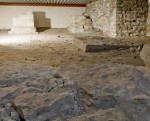 A five bedroom, centrally located town house in charming downtown Visby, capital of the Swedish island of Gotland, has just gone on the market with quite the unique selling point: there’s an exposed skeleton in the cellar, perpetually at slumber in his glass-covered grave.
A five bedroom, centrally located town house in charming downtown Visby, capital of the Swedish island of Gotland, has just gone on the market with quite the unique selling point: there’s an exposed skeleton in the cellar, perpetually at slumber in his glass-covered grave.
 The house was built in the 1750s over the foundations of a Russian Orthodox church which was abandoned in the Middle Ages. The skeleton, dubbed Valdemar by the locals, was a parishioner, probably a Russian, who was buried in the crypt of the church in the 13th century. There’s also another skull in a glassed-in niche in the cellar. Excavations in the 1970s uncovered the church walls and the human remains, and also found evidence of human habitation on the spot going back 4000 years. How’s that’s for a historical property?
The house was built in the 1750s over the foundations of a Russian Orthodox church which was abandoned in the Middle Ages. The skeleton, dubbed Valdemar by the locals, was a parishioner, probably a Russian, who was buried in the crypt of the church in the 13th century. There’s also another skull in a glassed-in niche in the cellar. Excavations in the 1970s uncovered the church walls and the human remains, and also found evidence of human habitation on the spot going back 4000 years. How’s that’s for a historical property?
“The man is resting in consecrated, sacred ground so his soul definitely rests at peace,” Leif Bertwig, the real estate agent in charge of the sale, told The Local. Therefore no ghosts are listed in the realtor’s description.
“If any prospective buyers would be worried that he will haunt the house they have nothing to fear,” Bertwig said.
Way to scare off the ghost-loving clientele, Leif. You should be draped in ectoplasm and flitting around at showings.
 The cellar is not accessible directly from the town house. Four houses, including this one, share a private central courtyard. Valdemar and the remains of the church can be accessed via a spiral staircase in the courtyard.
The cellar is not accessible directly from the town house. Four houses, including this one, share a private central courtyard. Valdemar and the remains of the church can be accessed via a spiral staircase in the courtyard.  The patio off the living room, a stone cobbled outdoor space featuring the remains of a medieval well, is right above Valdemar’s resting place. You can sip a beverage in front of your medieval well and remember that thou art mortal.
The patio off the living room, a stone cobbled outdoor space featuring the remains of a medieval well, is right above Valdemar’s resting place. You can sip a beverage in front of your medieval well and remember that thou art mortal.
However historically valuable the silent houseguest may be, Bertwig thinks that his underground presence will not affect the final price of the property, with bidding starting at 4.125 million kronor ($652,000).
“It’s definitely not a negative thing, more like a curious detail. Buyers will more likely be attracted to what the house looks like and how it’s built,” said Bertwig.
 It looks great. It was renovated in 2000 and has some contemporary elements that jar a little with the beautiful exposed wooden beams and plaster walls reminiscent of Tudor construction, but it still exudes history from every corner.
It looks great. It was renovated in 2000 and has some contemporary elements that jar a little with the beautiful exposed wooden beams and plaster walls reminiscent of Tudor construction, but it still exudes history from every corner.
As an archaeological and a historical home, the property is protected by law. You can’t alter the foundation in any way. You can, however, Leif assures us, take some folding chairs and a table downstairs and enjoy a picnic with Valdemar.
Here’s the listing with a detailed descriptions of all the features and contact information should you have $652,000 burning a hole in your pocket.